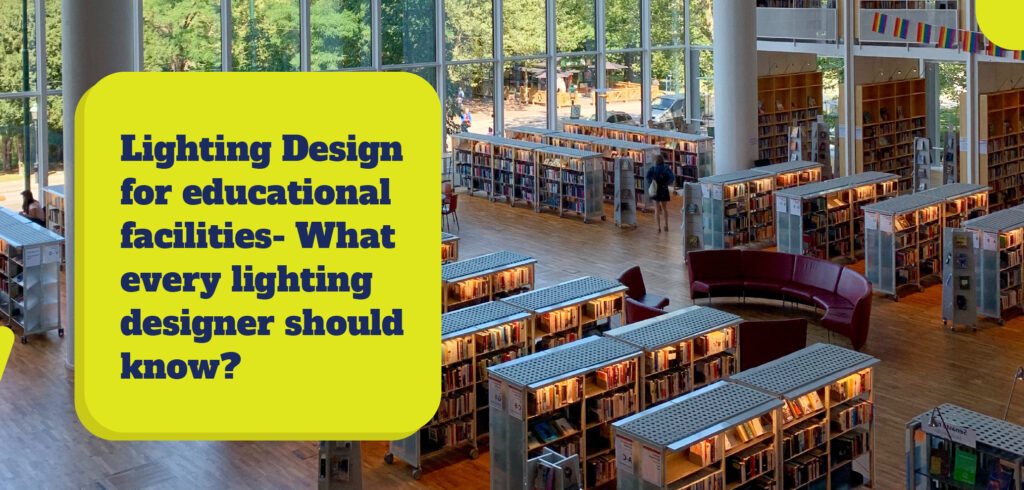Lighting Design for educational facilities- What every lighting designer should know?

Lighting design has a significant impact on student wellbeing; hence as a lighting designer, you should consider occupant’s comfort and energy savings as the primary goal. A good lighting design requires an in-depth understanding of the geography, building usage patterns, location, and placement of devices. Incorporating appropriate lighting control strategies will meet the requirements expected. However, you will have to face diverse challenges while employing lighting controls. This blog will provide details on overcoming design challenges and tips to effectively design lighting controls, thereby dramatically reducing energy wastage without compromising the lighting quality.
So as a designer, what is your primary goal while designing lighting for an educational facility?
For sure, it is to provide comfortable lighting for movement and other required tasks. Right? But, when it comes to an educational facility lighting, you should take care of the following factors to provide maximum benefit for students and staff. And they are;
- The psychological impact of the lighting design
- Key design elements including feature walls or custom artworks that enhance the space
- Daylight optimisation to support lighting requirements and improve the learning quality
- The use of motion sensors to provide comfort and energy savings
How can you achieve these?
You need to follow the three basic design principles.
- Function: Define the function of the space and use the appropriate strategy to meet the intended use.
- Aesthetics: Designers should focus on lighting controls design that maximizes the psychological and physical impact without affecting the functionality of different spaces.
- Energy Efficiency: Sustainable lighting system is the need of the hour, and you as a designer should choose appropriate lighting control solutions to ensure the same!
Each building requires a unique lighting control configuration to meet the significant designing principles. It is essential to decide upon the lighting controls system at the project’s initial phase.
Understanding the requirement of each space gives a baseline for designing. It is vital to incorporate the best lighting controls solutions that meet the essential functions of each room.
Space by Space Lighting Considerations
An educational facility has different spaces like classrooms, library, corridors, cafeteria and conference hall. The lighting requirement and the visual challenges of each space will be different. If the classroom lighting is dull with glares, students tend to be distracted and complain about eyestrain, fatigue, and tiredness.Whereas, spaces like a library, conference halls, corridor, and cafeterias are multi-functional spaces that require warmer lighting for comfort and reduced glare.To provide quality lighting that ensures overall wellbeing of occupants you can:
- Provide vertical illuminance for bookshelves
- Task lighting for workstations
- Minimise reflections or glare
- Higher illuminance for areas used by persons with impaired vision

As a lighting designer, you should be well aware of the best lighting control strategies that suit well for each space. The most commonly deployed lighting controls strategies for educational facilities are Daylight Controls, Scheduling, Occupancy sensors, Task Lighting, and Plug Load Controls.
Read on the blog: Top Six Lighting Control Strategies for energy-efficiency for more details
Designing and deploying lighting control strategies is not easy. You will face challenges, and numerous factors need special attention. Please take a look,
Daylighting Design
Considering the benefit of natural light on students’ wellbeing and overall performance, you will maximize the use of daylight. However, designing daylighting is a real challenge.
In daylight designing,
Building parameters play a crucial role. And you should take measures to control;
- Daylight Penetration and Glare
- Glare from Direct Sunlight
- Glare from Diffuse Skylight
Tips
Provide spatially balanced illumination
Side lighting shouldn’t be more than twice the window head height
Colour Temperature
Another essential aspect in lighting control design is colour temperature. The right colour temperature creates a perfect mood that inspire students to learn, feel comfortable and concentrate. The below table details the appropriate colour temperature for each space scenarios.

Reflectance
Luminance ratio and reflectance is a significant concern of lighting designing. The luminance ratio is the subtotal of the display’s brightness/black brightness and the reflected ambient light. Reflectance is the amount of light reflected by a surface and different elements determine the reflectance value.

As a designer, you should strive to provide:
- Adequate lighting for the most common visual job done in the space
- Ensure recommended reflectance for visual comfort and convenience
- Keep 40 to 60% reflectance for wall surface
- Be specific about the colour of blinds or drapes with similar reflectance
- Floors can have reflectance approaching 25%
Glare & Flicker
Glares and flickering lights are a significant concern of educational facilities, especially classrooms. They cause visual discomfort and fatigue. You can create a comfortable lighting environment by using:
- Fenestration controls to prevent direct sunlight
- High reflectance and light colours for high levels of illuminance and brightness
In conclusion,
Lighting Designers should focus more on optimizing natural light resources and reducing the visual challenges for creating an invoking learning ambiance. Choosing a budget-friendly and easy-to-use lighting control solution is crucial in designing new projects or retrofits.
To read more about lighting controls design for educational facilities, reach us.